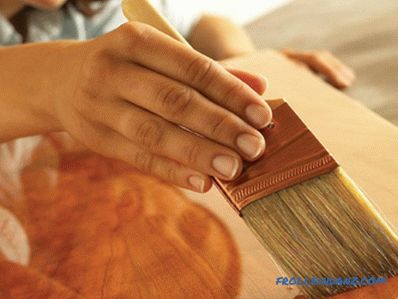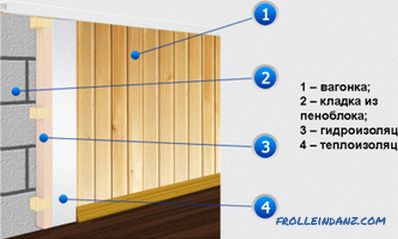There are no minor things in the kitchen. If you intend to make the kitchen truly functional, then you should carefully consider all the details of this room. This applies not only to the color of the facades and the number of lockers, but also to such seemingly prosaic things as desks and sinks. Designers have come up with many types of sinks for the kitchen, each of which is a certain popularity. We offer you to get acquainted with practical advice on choosing a sink for the kitchen.
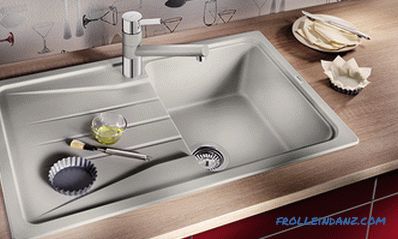
Choosing the type of installation for washing
Washing dishes is an inevitable process that you will do every day, or even several times a day. Not only the quality of the result depends on the convenience of washing, but also your mood and the state of the nearby furniture. Spray - an indispensable companion element of washing plates, spoons and mugs. Several requirements are put forward to the design of the sink, following which you can choose the best option. Wash should be: spacious; convenient in work; fit well into the kitchen design; Do not make loud noises when using.
Overhead
When choosing a sink should be guided by the type of furniture selected for the furnishings of the kitchen. If you have a standard kitchen set, then there should be a place for washing - a stand with special fixings. It is recommended to calculate its location at the stage of creating a design project - the module with the sink should be located in a convenient place, at some distance from the side wall, in order to avoid interference in the work.
Naturally, the water supply should also be designed for connection to this type of equipment. In most cases, a hole is made under the mixer in the sink, in the assembled state they represent one design.
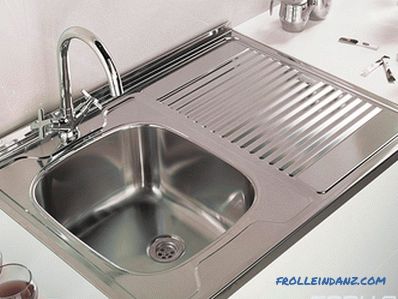
Steel washbasin.
But the peculiarities of the bowl make it possible to use wall mixers. This is somewhat less common, but, undoubtedly, has the right to life - this type of installation saves space and makes working space more convenient.
An indispensable attribute of an overhead washing is a rim protruding above the table top and protecting adjacent surfaces and the wall from splashes. Such bumpers can be of different heights and shapes, but they must be provided for sure. Washing joints with other equipment modules must be sealed to prevent water from flowing inside the structures.
Mortise
Sinks that are installed in a special slot in the countertop. They can even be called traditional. Such designs are more common in modern kitchen interiors. Their distribution contributes to a large number of design options and functionality, including the presence of one or more bowls, wings, rear or side walls, additional working surfaces.
By the way of installation, the mortise washers can be divided into three large types:
- top-mounted;
- flush;
- bottom, under the countertop.
The first option is the most common and most convenient both during installation and during operation. It is also very beneficial in design - the variety of designs and materials used makes it possible to turn a purely functional element of a kitchen setting into a decorative one.
With the top installation, it is enough to cut a hole in the tabletop, corresponding in size to the contours of the bowl below the rim. After installing the sink, a side (wide enough in this type of structure) comes onto the tabletop and completely covers the joint.
When installing the mortise sink, it is necessary to seal the perimeter of the slot contour so that the water that accidentally falls outside the bowl does not flow into the drawer. Such sinks, most often, are installed on wooden and MDF countertops, so waterproofing plays a big role. When installing in stone or glass countertops there are no such requirements for the sealing level, but, nevertheless, it is necessary to isolate the space under the sink from the ingress of water - this will relieve unpleasant odors and the appearance of mold.
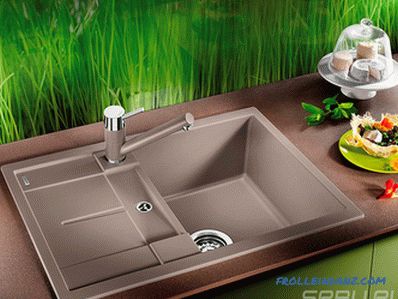
A flush-mounted sink installed on top.
Flush sinks are also installed in all types of countertops, but more often in stone and glass. During installation, they require very high precision preparation of the mounting hole - the side of them is very narrow, or not at all. If you are not sure about your own mastery, then it is better to use the services of a master
If the mixer can be installed either on the sink, or on the countertop or wall, when installing the sink, it is not possible to install a tap when flush-mounted on the sink. The choice depends on the configuration of the plumbing system and the mixer version. In both cases it is convenient to use the mixer and its replacement does not cause problems, as well as replacement of the sink itself.
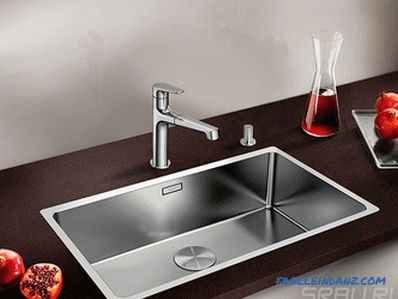
Sink mounted flush with the table top.
The installation of the sink below, under the worktop, causes the greatest difficulties.In this case, it is completely below the tabletop level, which imposes some restrictions on the use of this system - usually this option is used in the presence of a stone or glass tabletop. As in the previous case, the installation of the mixer is made on the wall or tabletop.
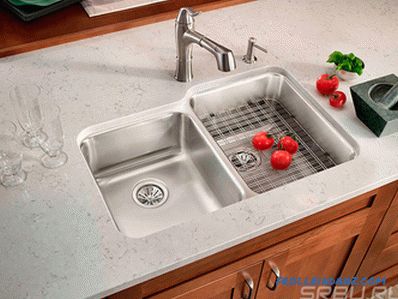
Sink installed under the countertop.
To advise how to choose a sink for the kitchen, you can only see the full version of the room design and accurately know the configuration of the water supply network. As a rule, all decisions on the choice of washing should be made during project preparation. Upon purchase, it is necessary to check the presence of all fastening elements so that during installation there are no difficulties and delays.
Other installation methods
There are other options for installing sinks in the kitchen. There are many ways to furnish a kitchen and design of its design, for which the above described sinks are absolutely not suitable. Here it is more appropriate to wall mount or install on a separate table. This is especially true of cast iron sinks, which are produced only for this type of installation.
Kitchens decorated in folk-style, high-tech or modern, as well as modern eclecticism, also allow installation of sinks in unusual places and with rather non-standard fixings. But in pursuit of extravagance and original design, we should not forget that washing is an exclusively functional element of the decor, and one should not sacrifice ease of use even for the most sophisticated design.
How to decide on the design of the sink
Manufacturers of sanitary and kitchen equipment offer various options for washing and it may seem that it is rather difficult to determine which sink is best for the kitchen. In fact, the design of the kitchen and personal preferences play a big role here, but besides this, it is necessary to take into account practical aspects of using the sink, the possibilities of the kitchen set and the kitchen room as a whole.
Number of sink bowls
According to the number of bowls, the sinks can be:
- with one bowl;
- with two bowls of the same size;
- with two bowls of different sizes;
- with three bowls.
In its classic form, the kitchen sink has one bowl, the immediate purpose of which is washing dishes.
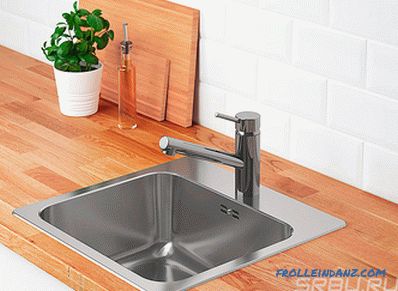
The advantage of two-bowl sinks of the same size is their convenience and versatility. In this case, you will have two bowls, in one of which you can, for example, soak a burnt pan or frying pan, and in the second wash dishes.
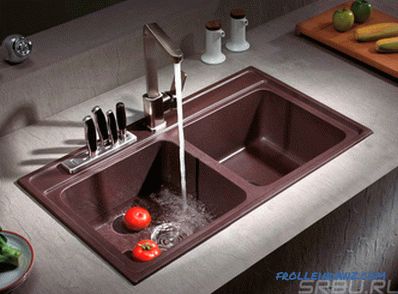
Sinks with two bowls, of different sizes, also expand the functionality of this kitchen appliance. For example, in a small bowl it is very convenient to wash and peel fruits or vegetables, while in a large bowl there will be dirty dishes.
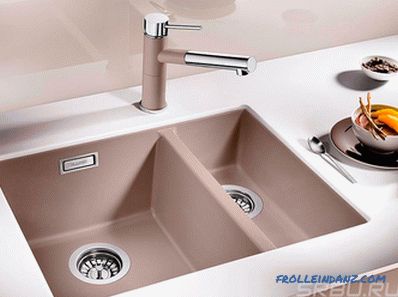
There are also sinks with three bowls, two of which are the same in size and the third one is a bit smaller. But it is desirable to install such sinks in large-area kitchens - they are rather cumbersome and not very convenient to use.
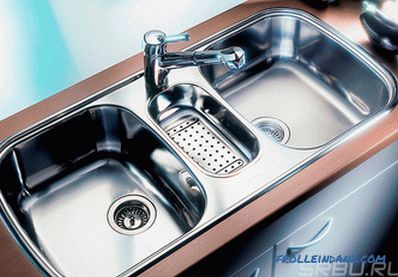
A necessary attribute of the sink is a drain. It is very good when it is equipped with a valve that allows you to collect a certain amount of water in the sink, for example, for soaking dishes. Some sinks are equipped with a drain and overflow, which is also quite convenient during operation. The presence of overflow is especially important if, when using a car wash, you often gather in its water.
Bowl Shape
Washing is performed with a variety of bowls:
Round.
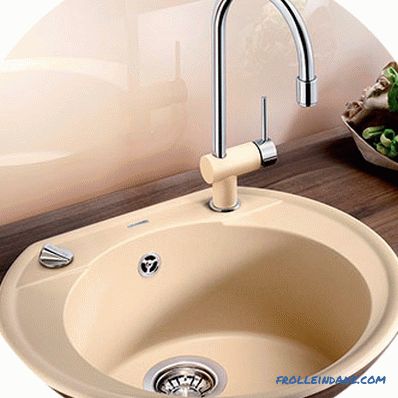
Rectangular.
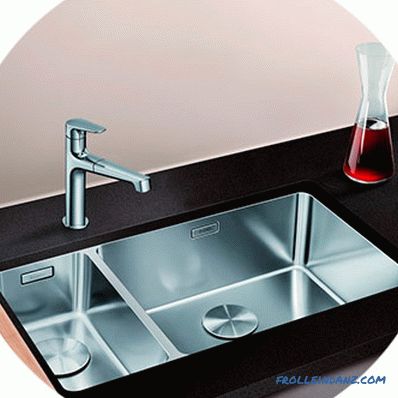
Square.
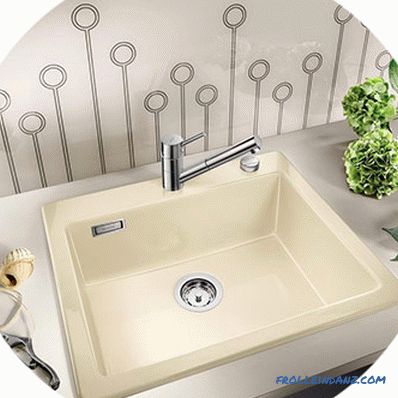
Oval.
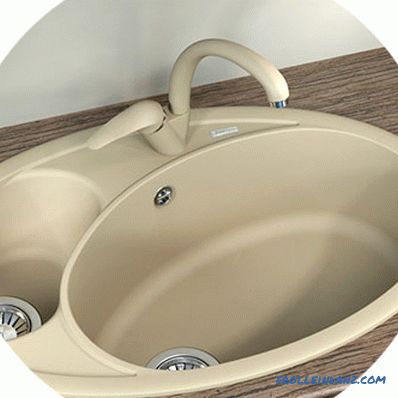
Trapezoidal.
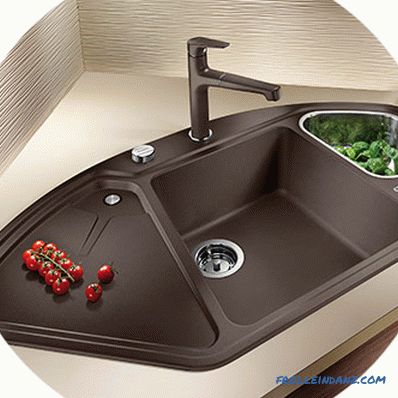
Practice shows that it is best to use square sinks with two bowls of different sizes. But the corners in the bowls should be rounded on a noticeable radius - this allows you to eliminate the "dead" zones and fully use the volume. Round bowls are also convenient, and when angled, they are triangular.
As with the choice of installation option, the shape of the bowl should be selected not only for aesthetic and design qualities, but, above all, for functionality. If you have a studio or a small one-bedroom apartment, you should not buy sinks for three containers with round bowls, a double is enough, or even a single one, but always with a side platform.
Bowl depth
The depth of the wash bowl is in the range of 120–200 mm, the ease of use and the amount of dishes that can be washed at a time depends on this parameter. In houses where large families live and food is often prepared, it is necessary to install sinks of great depth, at least 180 mm.
And in small apartments, where only a few plates or cups are washed at a time, 120-140 mm is enough.
In the presence of a drain with a valve, the depth of the wash also matters - the larger it is, the greater the volume of water for soaking dishes can be stored. But with a conventional drain, it is more convenient to wash with an average depth indicator. As well as in any, not only kitchen equipment, extreme indicators in the range of parameters are the least practical. The lowest ones lead to reduced ease of use and fragility of operation, and the maximum - to waste money. Most of the functionality is never used. The selection criterion should be reasonable minimalism.
The side around the bowl
The convenience and ergonomics of the wash also depend on the availability and shape of the sides. Almost every sink, larger or smaller, has sides. Often, ready-made holes for the mixer are made in them, or the place where they are most convenient to cut is planned. If your water supply system is designed for the installation of a wall-mounted faucet, then you should buy a sink with a narrow rim, a wide one will only interfere, and the hole will have to be muffled, which is ugly and leads to unnecessary expenses.
There may be several holes in the side, the purpose of which is not completely clear. They can be used as a mixer and detergent dispenser, as two mixers (in large sinks for several bowls), as an extra drain. If the purpose of the additional holes is not clear to you, or your water supply system and sewerage are not suitable for them, choose another option.
Sinks with a wing or without a wing
The amount of time spent on washing dishes depends on the type of sink to choose for the kitchen. The workplace should be comfortable and ergonomic, and the equipment for washing dishes with good reason can be called the workplace of a housewife (or a bachelor, as well as any amateur cookery).
An important element of a sink is a wing - a horizontal plane on one or both sides of the sink that overlooks the work area of a kitchen unit. In most cases, the wing is corrugated, with grooves directing the flow of water. But there are models with smooth wings. When buying or installing them, it is necessary to check the slope of the plane - it should be directed towards the sink, so that water does not stand and do not form puddles, which must be constantly cleaned. There are models and completely without wings, or with very narrow platforms.
Before choosing a washing option, you need to decide on your culinary inclinations - if you are not going to cook a lot and often, then the wing may not be necessary, but only occupy a scarce place.
But if you are keen on cooking or need to cook a lot and often, a spacious wing is a must. The wing is very convenient for arranging various kitchen utensils, preparing vegetables or drying dishes.
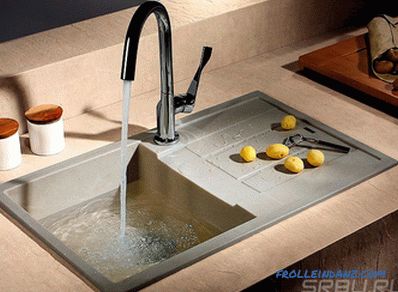
The wash can be performed with the right or left wing. The choice will depend on your personal preferences and features of the kitchen room.
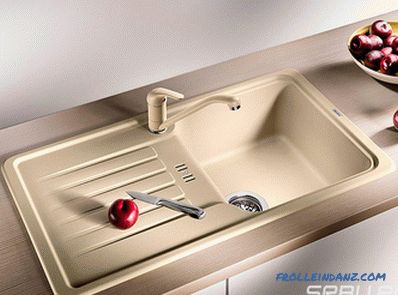
Sinks intended for bottom mounting, as a rule, are not equipped with a wing. Its role is performed by the surface of a glass or stone tabletop. But on wooden or MDF structures, it is desirable to install the wing - the water falling on them will eventually render the material unusable.
Choice of material for the manufacture of a wash
Stainless steel
The main and most popular material for the manufacture of a wash is stainless steel. But steel has become different. Manufacturers use different brands, not all of them are suitable for working in constant contact with water and detergents. Substandard steel can be recognized only after the appearance of corrosion stains on the surface of the bowl or wing.
This phenomenon is observed quite rarely, but it should be expected if you bought a car wash of an unknown manufacturer at a completely dumping price. If you intend to buy a stainless steel sink, then pay attention to the brand. As a rule, well-known manufacturers do not save on metal.
If the passport of the product or on the label indicates the steel grade from which the wash is made, then you can decipher its composition by the metal grade by opening any site on metallurgy. Quality steel must contain at least 18% chromium and 10% nickel, only in this case, a long service life is guaranteed.
Before you choose a stainless steel kitchen sink in the final version, you need to pay attention to the thickness of the metal from which it is made. If a sheet with a thickness of less than 0.5 mm is used in production, then you should not buy such a sink. Besides the fact that it will strongly rattle when a jet of water falls, damage by sharp edges of metal utensils or simply by hard objects is inevitable.
The thickness of the sink in the range of 0.6 - 0.9 mm is optimal. Such products are acceptable by weight, have sufficient mechanical strength and are not too noisy. Their price is quite affordable. This metal is used to wash all the most common structures.More expensive sinks are made from sheet thickness up to 1.2 mm. You can recognize them by welds between the structural elements. The seams are usually polished and sanded, but they can be noticed. The presence of welds, paradoxically, is an indicator of high quality and durability of washing.
The surface of stainless steel is polished to a mirror state, matted or decorated with a PVD coating. Mirror surfaces are the most beautiful, but require careful handling - the slightest scratches become noticeable and it is rather difficult to remove them.
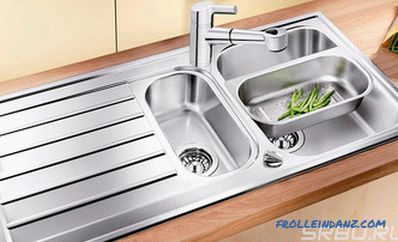
Matt washes are the most practical - stains, drips and small scratches are invisible on them. They are easy to wash - after the household kitchen facilities there are no stains, even light solvents do not leave traces on the surface. When processing abrasive powders for cooking stoves, the sink also retains its former appearance.
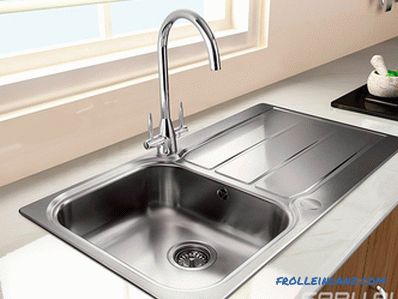
PVD surfaces are very decorative and quite durable. This method is applied to spraying a wristwatch, the quality of coatings of which is beyond doubt and is durable under rather harsh operating conditions. But beauty requires sacrifices - made under gold, copper, bronze or artificially aged coating is rather expensive. But such sinks are intended for exclusive interiors which are calculated on considerable financial expenses.

Artificial stone
Sinks of this material have recently received considerable distribution and are not inferior in popularity to stainless steel. Artificial stone - a mixture of natural raw materials with polymeric binders. The filler is marble or granite chips or quartz agglomerate. After solidification, the mixture is characterized by high strength, smooth surface and the ability to retain its shape under any mechanical and thermal effects.
An important argument in favor of choosing a sink made of artificial stone is a wide range of color solutions - you can choose both a complete imitation of natural minerals, and completely original colors and textures that are not found in nature. Worktops are often made from polymer-mineral composites, having correctly selected the sink and the upper part of the table, you can get very beautiful combinations that decorate the kitchen interior.
Stone sinks are virtually silent, not subject to corrosion, not afraid of detergents and organic solvents. Mechanical strength is also quite high, as well as temperature resistance.
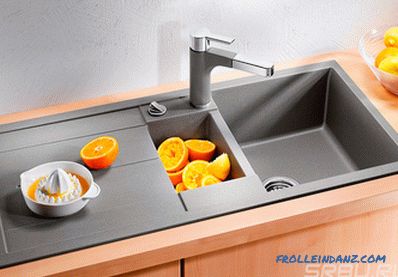
There are several types of stone sinks. All of them are made of natural and synthetic materials whose properties to a certain extent resemble stone.
The most common materials for the production of stone sinks are:
- porcelain stoneware;
- acrylic stone;
- agglomerate.
We have previously written about stone sinks of various types, where we compared their positive and negative sides, therefore we will not repeat here.
- On comparing different stone sinks you can read in the article: Advantages and disadvantages of stone kitchen sinks.
Ceramics
Ceramics sinks are also characterized by similar properties. They are less common, but also found in the collections of many manufacturers. By the number of colors, they are significantly inferior to artificial stone, they are also less durable, but harder and more difficult to install. interiors.

Cast iron
With one sound of this word, there is a feeling of massiveness and reliability. This is exactly what cast iron sinks are. They are produced by casting and are covered with a rather thick and durable layer of enamel of different colors. But mainly white and bluish products are in demand because of their attractive appearance and practicality. Some manufacturers of cast iron sinks, such as the Kohler factory, rely on original forms - many models of sinks can be considered works of art.
Like cast-iron baths, sinks are characterized by high heat capacity, high weight and high requirements for fastener strength. Enamel is very sensitive to sudden temperature changes, and strikes with massive objects or the fall of metal tools or utensils can cause cracks not only on the enamel, but also in the body of the product itself.
In most cases, cast iron sinks are designed for wall mounting, but there are also mortise models. The simplicity of care for the surface enamel is not inferior to stainless steel, but is more sensitive to abrasives. So that the enamel does not lose luster, it is better to wash it with soft sponges and a cloth, not using metal grids and brushes.
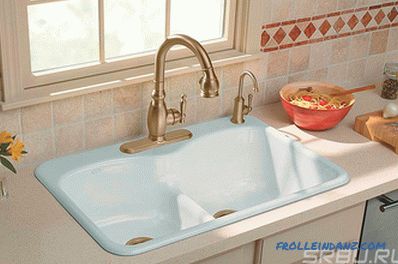
Sinks from other materials
In addition to stainless steel, artificial stone and cast iron, washing can be made of other materials:
- glass;
- natural stone;
- copper;
- bronze;
- polymers.
There are even wooden sinks. But usually all the washers from non-standard materials are piece goods made for a specific interior. They are expensive, except for the functional, they have a high decorative value and are not widespread. Much more often it is possible to meet the sinks combined. They are made from several materials, for example, a stainless steel bowl and a glass wing, or a stainless or bronze wing on a stone bowl.
In most cases, combined washes are much more practical than those made from the same material. Very often, their prices are not higher than the cost of ordinary kitchen equipment and anyone can buy them.
Selecting additional accessories for washing - the likeness of a colander with a mount aboard sink. Simple at first glance, fixtures can save up to 25% of the time when cooking various dishes and cleaning the kitchen.
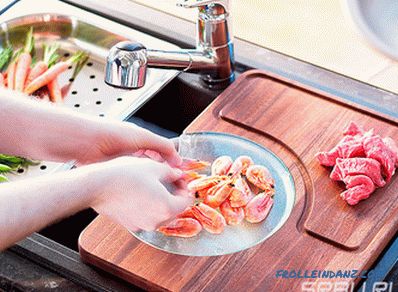
Sink with a sliding cutting board.
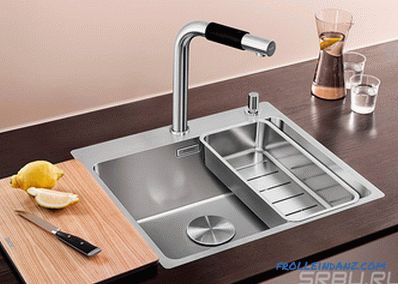
Collander for washing.
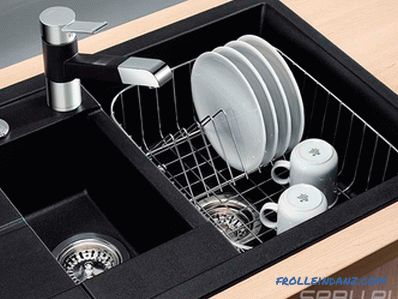
Dish dryer.
An important device that can be added to the sink siphon is a disposer - shredder of waste products. The shredder turns pieces of waste from vegetables, fruits and other products into a homogeneous gruel that is easily washed off with water. Practice shows that in the presence of a dispenser, the need for cleaning sewer pipes occurs an order of magnitude less often.
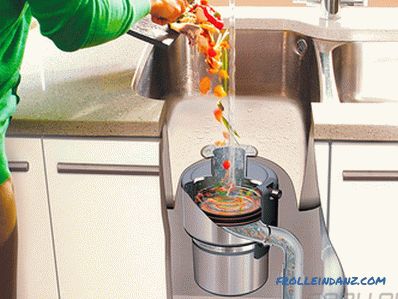
Disperser in section.
Each of the manufacturers of kitchen equipment offers its own options for sinks and accessories. When choosing, one should look not only at the level of design, but also at practicality of use. Sink is always in demand, even if there is a powerful dishwasher in the kitchen.

